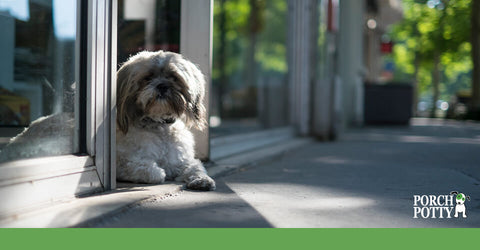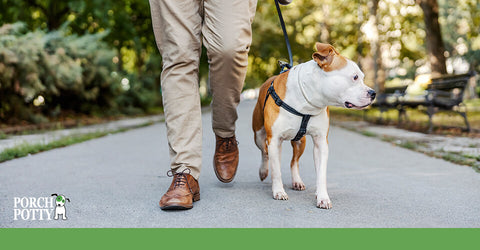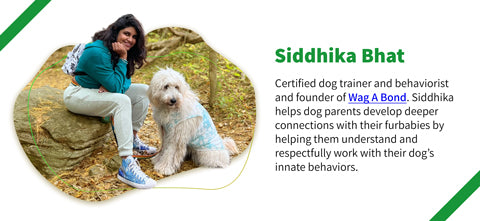
A Shih Tzu lays on the doorframe of a sliding glass door halfway in and halfway out of the house.
Being a pet parent sometimes means spending half our time in getting our dogs to get accustomed to loving and preferring indoors for play and potty and spending the rest of the time wondering why they don’t like to go outdoors anymore! It is important to properly think through every habit we set for our dogs because these habits can be hard to change later and may overlap with other aspects of their lives. Eg, a dog’s potty habits may affect their play time, outdoor preferences, meal times etc. Thus, changing one habit may have a ripple effect.
Expert Opinion
Dogs are capable of learning through conditioning, associating specific behaviours with outcomes. Consistent reinforcement for eliminating in the right location helps establish the desired behaviour. However, while being conditioned to adopt a new habit or a routine, dogs also learn to form their own preferences. The combination of training and personal preferences is instrumental in a dog learning to eliminate in designated spots.
Over time, most dogs associate certain areas with specific behaviours or a series of behaviours. Eg, many dogs associate their designated pee spot with not only relieving themselves, but also play. Thus, when we successfully transition them from outdoors to indoors, it is likely that they may end up fulfilling their potty needs as well as play needs indoors, thereby eliminating the need to go outdoors altogether.
Having said that, every dog is different as well as their stimulation needs. With some training, routine setting and positive reinforcement, they can be taught to adapt to a good balance between indoors and outdoors.
3 Benefits of Investing in Indoor Potties
The convenience it offers
Not enough things can be said about the convenience that this product packs. It is the ideal solution for apartment dwellers as it eliminates the need for frequent pee/potty walks, especially when raising a young puppy. Not every dog may be a fan of snow or rain. Apprehension in stepping out in the cold or rainy weather can be a huge hindrance in the potty-training process, thereby leading to more accidents inside the house.
Porch Potty makes for the perfect set up, regardless of the weather outside. Dogs who are adept at using indoor potty-training solutions are known to adapt better at boarding facilities where pee and poo walks may not happen very frequently.
Enables better monitoring of the dog’s health
Urine colour is one of the most important indicators of a dog’s physical well being. Identifying urine colour and consistency in an outdoor setting can be tricky. Porch Potty makes it easier to monitor your dog’s urinary and faecal waste, thereby enabling you to better care for your dog’s health.
Makes for an ideal option for senior dogs
Senior dogs and dogs with mobility issues need extra TLC on a daily basis. Taking them out frequently for pee and poo breaks may not be a feasible option. Indoor solutions like Porch Potty make for an ideal set up for such dogs as they have an option to relieve themselves as and when they need. This is crucial for such dogs as excessive bladder control may cause them added inconvenience and health issues.
If your dog is accustomed to relieving themselves outdoors all their life, the transition process may be time consuming. However, once done, it is nothing short of a blessing in disguise.

A Pitbull and its owner go on a nice long walk to get some exercise.
Balancing Indoor and Outdoor Activities
Follow a consistent ‘outdoor play’ routine
Although many dogs associate going outdoors with relieving themselves, this doesn’t have to be the case with every dog and with some amount of training and routine setting, this association can be changed. Every dog, regardless of age, breed and size, needs some amount of exercise and outdoor time.
Make it a point to take your dog outside when they are at their most energetic. Typically, this is in the evenings for most dogs. The likelihood of your dog loving the outdoors is higher if they associate it with play and other fun activities, rather than just relieving themselves.
Engage in your dog’s preferred activities outdoors
Different dogs engage in different activities when outdoors. Some dogs like to play, some love to sniff, some prefer walking whereas some prefer observing the world go by. Figure out what your dog likes to do best and make sure to give them a chance to engage in those behaviours outdoors.
This will make the experience of being outdoors more rewarding for your dog. It wouldn’t hurt to switch things up a bit by taking a new route every now and then or taking your dog out to new places such as beaches, lakes, hikes, trails etc.
Provide ample rest and down times at home
If your dog is getting all of their exercise needs fulfilled at home, they will have no reason to step outside. Keeping a dog engaged indoors is as important as ensuring that they get ample down times periodically. Timely rest and relaxation contribute to better physical and mental health, behavioural balance, promote predictability and security and prevent overexertion in dogs.
Scheduling downtimes as a part of their daily routine will make sure they are up for outdoor play and stimulation at least once a day.
Indoor overstimulation combined with indoor potty option is likely to deter dogs from stepping outside altogether. Make sure to save some amount of play and activities only for outdoors to help your dog look forward to it.
Limit access to the Porch Potty for only pee and toilet purposes
Dogs engage in different kinds of pre- and post- toilet behaviours. Many times these behaviours are play centric. Letting them engage in excessive play around the Porch Potty may fulfil their exercise needs altogether and may deter them from stepping outdoors.
Furthermore, letting dogs get too comfortable around the Porch Potty may encourage them to sleep or rest on it, thereby discouraging them to pee on it. Limiting access to the porch potty is important to strike an ideal balance between having the dog peeing indoors and keeping the excitement for outdoors alive. Closely monitor your dog’s behaviour during the training process to eliminate mistakes.
Don’t underestimate the power of positive reinforcement
Positive reinforcement is one of the most absolute techniques to help dogs learn faster. Positive reinforcement does not just mean giving treats for desirable behaviours. When encouraging dogs to play outdoors, here’s how positive reinforcement can work wonders –
- Engage in your dog’s favourite activities outdoors
- Reward your dog for stepping outside willingly
- Allow your dog to come back home as and when they please
- Take your dog outdoors when they are at their most energetic self
Allow your dog to come back home if they seem uncomfortable outside
It is common for pet parents to try and encourage their dogs to stick around outdoors for a longer time, especially when the dog seems to be anxious or in a hurry to rush back home. This, however, may be counterproductive as the dog may end up feeling trapped outdoors, thereby discouraging them to step outside the next time. If the dog has an option to rush back home as and when they need to, it will help them feel a lot more comfortable outdoors.

A Jack Russell Terrier plays with a yellow ball in a grassy garden.
Troubleshooting
“My dog is unwilling to step outside since the Porch Potty”
Several dogs associate the outdoors with relieving themselves as well as play. An indoor turf can make life easy for dogs as it gives them the liberty to relieve themselves any given time of the day. This can often take away the need for pets as well as pet parents to repeatedly step outside. This change in routine may cause further resistance from dogs to go outside. While it is important for dogs to have some amount of outdoor time for fresh air and stimulation, it is not imperative that they spend excessive amounts of time playing outdoors, especially if they get their toilet needs and play needs fulfilled at home.
“My dog seems to be in a rush to come back home when outside”
There could be several reasons why a dog could lack interest in the outdoors, such as lack of stimulation in the outdoor environment, anxiety issues, lack of socialisation, unfavourable weather conditions and so on. Try to keep walks short and stimulating by letting your dog sniff to their heart’s content. If your dog is anxious or reactive on walks, step out during unpopular times to prevent stressful episodes.
Give ample outlets for play to your dog. Play helps alleviate stress and anxiety in dogs. It releases endorphins, which are natural mood elevators. Play also provides an outlet for pent-up energy and help reduce stress-related behaviours.
“Will transitioning my dog from peeing indoors to outdoors be a challenge?”
The answer to this question is not a simple black or white. Transitioning a dog from old behaviours to new ones depends on a variety of factors such as age of the dog, how long the dog has been practising the behaviour, the ease of performing the new and old behaviour, etc. Furthermore, if your dog is habituated to the surface of the Porch Potty and the convenience it provides, switching to a new designated area may be a challenge. Having said that, it is not an impossible endeavour. With a consistent routine, keeping your dog’s preference in mind and loads of positive reinforcement, the transition process can be a lot smoother.
Testimonial
Tiana Phillips, a very happy Porch Potty customer, says, “I just wanted to say that the Porch Potty enabled me to be able to get, and keep my Mastiff puppy. I have some health issues right now, and am often quite dizzy first thing in the morning. With the Porch Potty I can just let Lena out on the balcony, and she takes care of business. It’s also very nice to have in rainy weather, which is most of the time in Oregon. It’s also great at night! It did not diminish her learning to go outside where she is supposed to go, either. Thanks for a great product. I have recommended it to a number of my clients.”
Every dog is unique, and their potty training needs may vary, so as their preference towards outdoor play. By understanding and responding to your dog's behaviour, you can create a positive and effective potty training experience indoors and an ideal play and exercise routine outdoors. Take into consideration your dog’s preferences and habits and he will help you hit that sweet spot in no time.
Siddhika Bhat, Certified dog trainer and behaviourist and founder of Wag A Bond.
For more information on training your dog, check out these articles:




